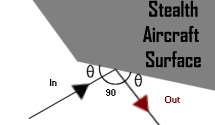





So how is the shape of the aircraft made? Well this is where we get into the Top
Secret stuff. In short, only government engineers and a privileged few know the
answer to that  question. All we know is what I said to the left, that the “stealth
shape” is made to minimize right angles so when RF signals strike the aircraft surface
they are not reflected back to their source as seen below.
question. All we know is what I said to the left, that the “stealth
shape” is made to minimize right angles so when RF signals strike the aircraft surface
they are not reflected back to their source as seen below.
The last part that makes an aircraft stealthy to radar is what makes up the skin of the aircraft. The radar absorbent material or RAM is a type of paint that absorbs RF signals and effectively prevents them from going back to their source. Again, the make up of RAM is also classified.


Modern stealth aircraft are undetectable in 5 main areas: visual, acoustic, heat,
infrared, and radar. In this site we will focus on the last area, radar. Making
up ninety percent of what makes an aircraft stealthy is its shape. Through a combination
of angles called planform shaping. American aerospace engineers began to research
and test these planform or stealth shapes as early as the late 1940’s but it was
not until the 1950’s when a little know book by a Russian physicist surfaced in the
United States that stealthy shapes were first derived and used. The book by Pyotr
Ufimtsev entitled "Method of Edge Waves In The Physical Theory of Diffraction" became
known by many aerospace engineers as the “Rosetta Stone” of the stealth shape. Ufimtsev
was able to provide calculations on how radio waves reflected off of different shapes.
Since radar, or RAdio Detection And Ranging, is an electromagnetic radio wave that
is emitted by a radar antenna. It was easy to apply Ufimtsev’s equations to radar.
Radar is used to identify the range, altitude, direction, or speed of, in this case,
an aircraft. To find these values a radar transmitter, transmits radio-